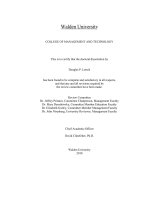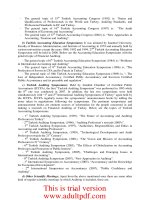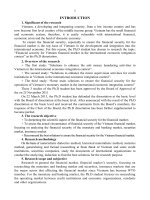Financial accounting in an economic context 8e chapter 012
Bạn đang xem bản rút gọn của tài liệu. Xem và tải ngay bản đầy đủ của tài liệu tại đây (547.11 KB, 30 trang )
1
Chapter 12
Shareholders’ Equity
2
Chapter 12: Shareholders’ Equity
How to Finance the Corporation?
Borrow
– Notes, Bonds, Leases
– The debt holders are legally entitled to repayment of
their principal and interest claims
Issue Equity
– Common and Preferred Stock
– The shareholders, as owners, have voting rights,
limited liability, and a residual interest in the corporate
assets
Retained Earnings
3
Relative Importance of Liabilities,
Capital, and Retained Earnings
(% of total assets)
4
Debt versus Equity
Debt
Formal legal contract
Fixed maturity date
Fixed periodic payments
Security in case of default
No voice in management
Interest expense deductible
Equity
No legal contract
No fixed maturity date
Discretionary dividends
Residual asset interest
Voting rights - common
Dividends not deductible
Double taxation
5
Distinctions between Debt and Equity
Interested Party
Debt
Equity
Investors /
Creditors
Lower investment risk Higher investment
risk
Fixed cash receipts
Variable
cash receipts
Management
Contractual future
cash payments
Dividends are
discretionary
Effects on credit
rating
Interest is tax
deductible
Effects of dilution/
takeover
Dividends are not
tax deductible
Accountants/
Auditors
Shareholders’ equity
Liabilities section
of the balance sheet
of the balance sheet
No income statement
Income statement
effects from equity
effects from debt
6
Preferred Stock vs Common Stock
Advantages
Preferred Stock
Common Stock
Preference over common in
liquidation
Voting Rights
Stated dividend
Rights to residual profits
(after preferred)
Preference over common in
dividend payout
Disadvantages
Subordinate to debt in liquidation
Last in liquidation
Stated dividend can be skipped
No guaranteed return
No voting rights (versus common)
Debt or Equity?
Components of both
Usually classified as equity
7
Sample Co. Shareholders’ Equity
Common stock, $1 par value, 500,000 shares
authorized, 80,000 shares issued, and
75,000 shares outstanding $ 80,000
Common stock dividends distributable
2,000
Preferred stock, $100 par value, 1,000 shares
authorized, 100 shares issued and
outstanding
10,000
Paid in capital on common
$ 20,000
Paid in capital on preferred
3,000
Paid in capital on treasury stock
2,000
25,000
Retained earnings:
Unappropriated
$18,000
Appropriated
4,000
22,000
Less: Treasury stock, 5,000 shares (at cost)
(6,000)
Less: Other comprehensive income items
(unrealized loss on AFS securities) (2,000)
Total Shareholders’ Equity
$131,000
8
Journal Entries-Sample Co.
Now, using Sample Company information, record the
following additional issues of common (CS) and preferred
stock (PS):
Issued 100 shares of PS at $102 per share:
Cash (100 x $102)
10,200
PS (100 x $100 par)
10,000
APIC - PS (plug)
200
Issued 500 shares of CS at $5 per share:
Cash (500 x $5)
2,500
CS (500 x $1 par)
500
APIC - CS (plug)
2,000
9
Treasury Stock
Created when a company buys back shares of its own
common stock.
Reasons for buyback?
The debit balance account called “Treasury Stock” is
reported in shareholders’ equity as a contra account to SE.
– Note: Treasury Stock is not an asset.
The stock remains issued, but is no longer outstanding.
– does not have voting rights
– cannot receive cash dividends
May be reissued (to the market or to employees) or retired.
No gains or losses are ever recognized from these equity
transactions.
10
TS Example from Sample Co.
Look again at the information for Sample Co.
Note that Sample Company has 5,000 shares
of TS at a total cost of $6,000, or a cost of
$1.20 per share. The journal entry to record
that purchase would have been:
TS
6,000
Cash
6,000
Note that Sample Company also has APIC - TS
of $2,000 in the balance sheet. This must be
from previous TS transactions, where the TS
was purchased, then reissued for more than
original cost. All that remains of those
transactions is the APIC -TS.
11
Sample Co. Shareholders’ Equity
Common stock, $1 par value, 500,000 shares
authorized, 80,000 shares issued, and
75,000 shares outstanding $ 80,000
Common stock dividends distributable
2,000
Preferred stock, $100 par value, 1,000 shares
authorized, 100 shares issued and
outstanding
10,000
Paid in capital on common
$ 20,000
Paid in capital on preferred
3,000
Paid in capital on treasury stock
2,000
25,000
Retained earnings:
Unappropriated
$18,000
Appropriated
4,000
22,000
Less: Treasury stock, 5,000 shares (at cost) (6,000)
Less: Other comprehensive income items
(unrealized loss on AFS securities) (2,000)
Total Shareholders’ Equity
$131,000
12
TS - Example Problem
Tiger Corporation has 100,000 shares of $1 par
value stock authorized, issued and outstanding
at January 1, 2007. The stock had been issued
at an average market price of $5 per share, and
there have been no treasury stock transactions
to this point.
Assume that, in February of 2007, Tiger Corp.
repurchases 10,000 shares of its own stock at
$7 per share. In July of 2007, Tiger Corp.
reissues 2,000 shares of the treasury stock for
$8 per share. In December of 2007, Tiger Corp.
reissues the remaining 8,000 shares for $6 per
share. Prepare the journal entries for 2007
regarding the treasury stock.
13
TS Example -Journal Entries
Feb: repurchase 10,000 sh. @ $7 =
$70,000.
TS
70,000
Cash
70,000
July: reissue 2,000 sh @ $ 8 = $16,000
(cost = 2,000 @ $7 = 14,000)
Cash
16,000
TS
14,000
APIC - TS
2,000
14
TS Example -Journal Entries
Dec: reissue 8,000 sh. @ $ 6 = $48,000
(cost = 8,000 sh.@ $7 = 56,000)
Cash
48,000
APIC - TS (1)
2,000
RE (2)
6,000
TS
56,000
Now we need to debit one or more accounts to
compensate for the difference.
(1) debit APIC -TS (but lower limit is to -0-).
(2) debit RE if necessary for any remaining
balance (this is only necessary when we
are decreasing equity).
15
Retained Earnings
We will be expanding the basic retained earnings
formula in this chapter. Now the Statement of
Retained Earnings will include the following:
RE, beginning (unadjusted)
xx
Add/Subtract: Prior period adjustment xx
RE, beginning (restated)
xx
Add: net income
xx
Less dividends:
Cash dividends-common
xx
Cash dividends - preferred
xx
Stock dividends
xx
Property dividends
xx
Less: Adjustment for TS transactions xx
Appropriation of RE
xx
RE, ending
xx
16
Example of Stock Split
IZM Company has 100,000 shares of $2 par value stock
authorized, 10,000 shares issued and outstanding.
The SE section of the balance sheet shows:
– Common stock
$20,000
– Retained earnings 80,000
The market price of the outstanding shares is $50 per
share before the split is distributed.
17
Example of Stock Split
If IZM declared a 2 for 1 stock split, the old shares would
be turned in and new shares would be issued with the
following description:
Common stock, $1 par value, 200,000 shares authorized,
20,000 shares issued and outstanding.
The total SE is still $100,000:
– Common stock
– Retained earnings
$20,000
80,000
The market price per outstanding share would now be $25
per share.
Note: No journal entry is necessary.
18
Stock Dividends vs Stock Splits
Going back to the original IZM information. Assume instead
that IZM declared a 100% stock dividend.
First, prepare the JEs to record the declaration and
distribution of the stock dividend for new shares (10,000
shares x 100% = 10,000 new shares x $2 per share =
$20,000):
Stock Dividends (RE) 20,000
Stock Div. Distributable
20,000
Stock Div. Distributable 20,000
Common Stock
20,000
19
Stock Dividends vs Stock Splits
Now note the new description for the stock
dividend:
Common stock, $2 par value, 100,000 shares
authorized, 20,000 shares issued and outstanding
The total value in SE is still $100,000:
– Common Stock
$40,000
– Retained Earnings
60,000
Note that the total market price per share would
change to $25 per share.
Thus, a 2 for 1 stock split and a 100% stock
dividend have the same effect on:
– total shareholders’ equity and
– market price per share
20
Stock Dividends vs Stock Splits
To summarize the effects on IZM Company:
100% Stock
2 for 1
After:
Dividend
Stock Split
Total sh. outstanding 20,000 sh.
20,000 sh.
Par value per share
$2
$1
Market price per share $25
$25
Total shareholders’ eq: $100,000
$100,000
General ledger results:
CS account
$ 40,000 $ 20,000
RE account
$ 60,000 $ 80,000
Reminder: CS was $20,000 and RE was $80,000
before the split or dividend. Since the stock
dividend required journal entries, the amounts for
CS and RE changed. Since the stock split does
not require a journal entry, the amounts for CS
and RE do not change.
21
Other Comprehensive Income
“Other Comprehensive Income” includes certain direct
equity adjustments that are not part of the current
income statement, but which may have an eventual
effect on income.
We already discussed one of these direct equity
adjustments when reviewing Available-for-sale
Investments. We found that any unrealized
gains/losses from revaluation to market are shown in
SE (as “other comprehensive income”) rather than on
the income statement.
22
Comprehensive Class Problem Shareholders’ Equity
Given the following SE balances for Company G at 1/1/07:
Common stock, $10 par, 50,000 shares authorized,
20,000 shares issued and outstanding
$200,000
APIC on common stock
400,000
Retained earnings 400,000
During 2007, Company G had the following activity:
1. Net income for the year was $250,000.
2. Cash dividends of $2 per share were declared and paid
on February 1.
3. On June 1, Company G repurchased 2,000 shares of its
own stock at $20 per share (using the cost method).
4. On December 1, Company G reissued 500 shares of
treasury stock at $18 per share.
5. On December 15, Company G declared a 100% stock
dividend, to be distributed to all of its shareholders
(including treasury), on Jan. 15, 2008.
6. At Dec. 31, Company G recorded an AJE to revalue its
available for sale investments from $20,000 to $32,000.
23
Comprehensive Class Problem Shareholders’ Equity (continued)
Required:
A. Prepare journal entries for items 2 through 6 (item 1
would require detailed information for revenues and
expenses to prepare - just know that the credit is to
retained earnings for $250,000).
B. the Statement of Stockholders’ Equity for Company G
for 2007.
C. Prepare the stockholders’ equity section of the balance
sheet for Company G for 2007, including the appropriate
description for the common stock.
24
Comprehensive Class Problem - Solution
A. Journal entries
1. No entry required.
2. Calc: 20,000 x $2 = 40,000
3.
Cash Dividends (RE) 40,000
Dividends Payable
40,000
Dividends
Payable
40,000
Calc: 2,000 shares x $20 = $40,000
Cash
40,000
Treasury Stock
Cash
40,000
40,000
25









